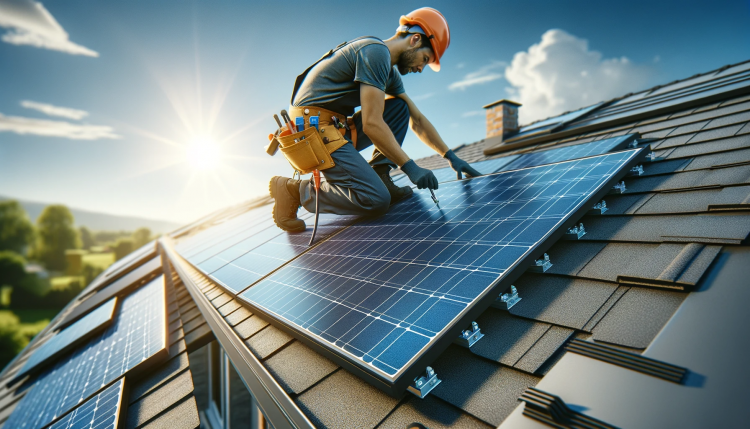
Installing Solar Panels: Harnessing the Power of the Sun
Embracing renewable energy is more critical than ever, and solar panels are at the forefront of this sustainable revolution. This comprehensive guide will walk you through the process of installing solar panels, from planning to execution, ensuring you can harness the power of the sun effectively and efficiently.
Understanding Solar Energy
The Basics of Solar Power
Solar panels convert sunlight into electricity using photovoltaic (PV) cells. This process is a clean, renewable source of energy that can significantly reduce electricity bills and carbon footprints.
Key Components:
- Solar Panels: The primary component that converts sunlight into electricity.
- Inverter: Converts the direct current (DC) electricity produced by the panels into alternating current (AC) used in homes.
Benefits of Solar Energy
- Reduces Electricity Bills: Solar power can significantly cut down on your utility bills.
- Environmentally Friendly: Reduces reliance on fossil fuels, decreasing greenhouse gas emissions.
Planning Your Solar Panel Installation
Assessing Your Solar Energy Needs
The first step in assessing your solar energy needs is to understand your current energy consumption.
Analyzing Your Energy Bills
- Monthly Consumption: Look at your monthly electricity bills to determine your average usage in kilowatt-hours (kWh).
- Peak Usage: Identify times of high energy usage, which can affect the size and type of system you need.
Evaluating Your Property’s Solar Potential
- Sunlight Exposure: Assess the amount of direct sunlight your property receives. This can be affected by geographic location, time of year, and shading from buildings or trees.
- Roof Assessment: Evaluate the condition, size, orientation, and angle of your roof. South-facing roofs in the northern hemisphere typically receive the most sunlight.
- Solar Potential: Use tools like Google’s Project Sunroof to assess the solar potential of your roof.
Tools for Assessment
- Solar Calculators: Online tools like the PVWatts Calculator from NREL can help estimate your roof’s solar potential.
- Professional Assessment: Consider a professional solar assessment for a more accurate evaluation.
Considering Future Energy Needs
- Future Plans: Factor in any anticipated changes like an electric vehicle, home additions, or a growing family, which could increase your future energy needs.
Choosing the Right Solar Panels


Types of Solar Panels
Understanding the different types of solar panels is crucial to making the right choice.
Monocrystalline Solar Panels
- Description: Made from single-crystal silicon, known for their black color and high efficiency.
- Pros: Higher efficiency and longer lifespan.
- Cons: Typically more expensive.
Polycrystalline Solar Panels
- Description: Made from multiple silicon fragments melted together, have a bluish hue.
- Pros: Less expensive than monocrystalline.
- Cons: Slightly lower efficiency and shorter lifespan.
Thin-Film Solar Panels
- Description: Made from a variety of materials like amorphous silicon or cadmium telluride, flexible and lightweight.
- Pros: Less affected by high temperatures, aesthetically pleasing.
- Cons: Require more space due to lower efficiency, shorter lifespan.
Efficiency vs. Cost
- Efficiency: High-efficiency panels produce more electricity in a smaller area but are more expensive.
- Cost-Effectiveness: Consider the cost per watt of electricity generated. Sometimes, slightly less efficient panels may offer better value for money.
Durability and Warranties
- Durability: Look for panels that can withstand environmental conditions like wind, snow, and temperature fluctuations.
- Warranties: A longer warranty period (usually 25 years) is a good indicator of panel quality and manufacturer confidence.
Aesthetic Considerations
- Appearance: Some homeowners prefer panels that blend in with their roof. Options include low-profile designs and solar shingles.
Brand Reputation and Reviews
- Research Brands: Look for manufacturers with a strong track record and positive reviews.
- Certifications: Ensure the panels meet industry standards and certifications for safety and performance.
Compatibility with Inverters and Batteries
- System Integration: Ensure the panels are compatible with your chosen inverter and, if applicable, solar battery storage systems.
Designing Your Solar Power System
Sizing Your System
- Calculate Your Needs: Based on your energy consumption and solar potential, calculate the size of the solar system required.
- Consider Future Use: Anticipate any future increase in energy usage.
Layout and Positioning
- Roof Analysis: Ensure your roof is in good condition and can support the weight of the panels.
- Panel Orientation: Panels should typically face south in the northern hemisphere for maximum sun exposure.
Getting the Right Permits
Navigating Legal Requirements
- Building Permits: Check with your local government for building permit requirements.
- Electrical Codes: Ensure your installation complies with national and local electrical codes.
Working with Utilities
- Net Metering: Understand how to connect your system to the grid and the policies for net metering in your area.
Purchasing Your Solar Panels
Choosing a Supplier
- Reputable Brands: Research and select a reputable brand known for quality and reliability.
- Warranties and Support: Look for panels with strong warranties and customer support.
Financial Considerations
- Cost Analysis: Consider the upfront cost versus long-term savings.
- Incentives and Rebates: Explore federal, state, and local incentives and rebates for solar panel installation.
Financing Your Solar Panel Installation
Understanding the Costs
The cost of solar panel installation can vary widely based on the size of the system, the type of panels, and your location.
Factors Affecting Costs:
- System Size: Larger systems will cost more but can generate more electricity.
- Panel Type: High-efficiency panels are pricier than standard ones.
- Installation Complexity: Roof condition, angle, and accessibility can impact installation costs.
Exploring Financing Options
Several options can make solar panel installation more affordable.
Solar Loans
- Description: Specific loans designed for solar installations, allowing you to pay over time.
- Benefits: Immediate ownership of the system, potential to save more over time than the loan costs.
Solar Leases
- Description: You lease the solar panels from a provider who installs them on your home.
- Benefits: No upfront costs, fixed monthly payments, maintenance often covered by the provider.
Power Purchase Agreements (PPAs)
- Description: You agree to purchase the power generated by panels installed on your property at a set per-kWh rate.
- Benefits: No upfront installation costs, rate is often lower than the utility price.
Government Incentives and Rebates
- Federal Tax Credit: Significant tax credit available for solar panel installation.
- State and Local Incentives: Varies by location, can include additional tax credits, rebates, and grants.
Detailed Installation Steps for Solar Panels


Preparing for Installation
- Safety First: Ensure you have the necessary safety equipment like gloves, safety glasses, and harnesses.
- Tools and Equipment: Gather all required tools including a drill, wrenches, and a ladder.
Step 1: Site Preparation and Safety
- Roof Preparation: Ensure the roof is in good condition and clear of debris.
- Safety Equipment: Use harnesses, gloves, and safety glasses to prevent accidents.
Step 2: Mounting the Brackets
- Spacing and Placement: Follow the manufacturer’s instructions for bracket spacing and placement.
- Securing Brackets: Use the appropriate tools to securely attach the mounting brackets to your roof.
Step 3: Installing the Solar Panels
- Panel Placement: Carefully lift and place the panels onto the mounting brackets.
- Securing Panels: Secure the panels to the brackets using the provided hardware.
Step 4: Electrical Wiring
- Wiring Panels: Connect the solar panels to each other and to the inverter using appropriate wiring.
- Grounding: Properly ground the system to prevent electrical hazards.
Step 5: Inverter Installation
- Location: Install the inverter in a cool, shaded location, often alongside the home’s main electrical panel.
- Connecting to Panels: Connect the inverter to the solar panels and the home’s electrical system.
Step 6: Connecting to the Grid
- Utility Approval: Ensure you have approval from your utility company for a grid connection.
- Professional Inspection: Have a certified electrician or a representative from the utility company inspect the installation.
Step 7: System Testing and Activation
- Testing the System: Ensure all components are functioning correctly.
- Activation: Once approved, activate the system and start generating solar power.
Installation Process of Solar Panels
Professional Installation vs. DIY
- DIY Considerations: While DIY installation can save costs, it requires a solid understanding of electrical systems and roofing.
- Hiring Professionals: For most, hiring a certified solar installer ensures safety and compliance with regulations.
System Testing and Commissioning
Ensuring Your System is Operational
- Initial Testing: Conduct initial tests to ensure the system is functioning correctly.
- System Commissioning: Have a professional inspect and commission your system, ensuring it meets all regulatory standards.
Maintenance and Care of Solar Panels
Regular Maintenance Tips
- Cleaning Panels: Regularly clean your panels to remove dirt, leaves, and other debris that could block sunlight.
- Monitoring Performance: Regularly check the performance of your panels and inverter to ensure they are operating at peak efficiency.
Troubleshooting Common Issues
- Inverter Issues: If your inverter is not functioning correctly, it can significantly impact your system’s performance.
- Panel Damage: Inspect for physical damage to the panels, which can reduce their efficiency.
Maximizing Your Solar Investment
Enhancing Efficiency
- Solar Battery Storage: Consider adding a solar battery to store excess energy for use during cloudy days or nighttime.
- Energy Efficiency Improvements: Implement energy efficiency measures in your home to further reduce electricity bills.
Staying Informed and Updated
- Technology Advancements: Keep up with new advancements in solar technology that could enhance your system.
- Policy Changes: Stay informed about changes in energy policy or incentives that could impact your solar setup.
The Future of Solar Energy
Emerging Trends
- Smart Solar Systems: Integration with smart home technology for more efficient energy management.
- Community Solar Projects: Opportunities to participate in shared solar energy projects.
Global Impact
- Renewable Energy Movement: The role of solar energy in the global shift towards sustainable and renewable energy sources.
Embracing a Sustainable Future
Installing solar panels is a powerful step towards energy independence and environmental stewardship. By understanding the intricacies of solar panel installation and maintenance, you can make informed decisions that maximize the benefits of solar energy. Embrace the sun’s power and join the renewable energy revolution!





